Frigidaire FFES3015LB, FFES3005LW, FFES3025LS, FFES3015LS, FFES3025LB User Manual
...
All about the
Use&Care
of your Built-In Range
TA B L E O F C O N T E N T S
Welcome & Congratulations ................................... |
2 |
Setting Oven Controls - Model A........................... |
15 |
Important Safety Instructions................................. |
3 |
Setting Oven Controls - Models B & C ................... |
17 |
Features at a Glance.............................................. |
6 |
Care & Cleaning (Cleaning Chart) ......................... |
23 |
Surface Cooking .................................................... |
9 |
Care & Cleaning .................................................. |
24 |
Before Setting Surface Controls ............................ |
11 |
Before You Call .................................................. |
29 |
Setting Surface Controls ...................................... |
13 |
Major Appliance Warranty .................................... |
32 |
Before Setting Oven Controls ............................... |
14 |
|
|
www.frigidaire.com USA 1-800-944-9044 |
www.frigidaire.ca Canada 1-800-265-8352 |
A .Rev 2012) (January 318205828
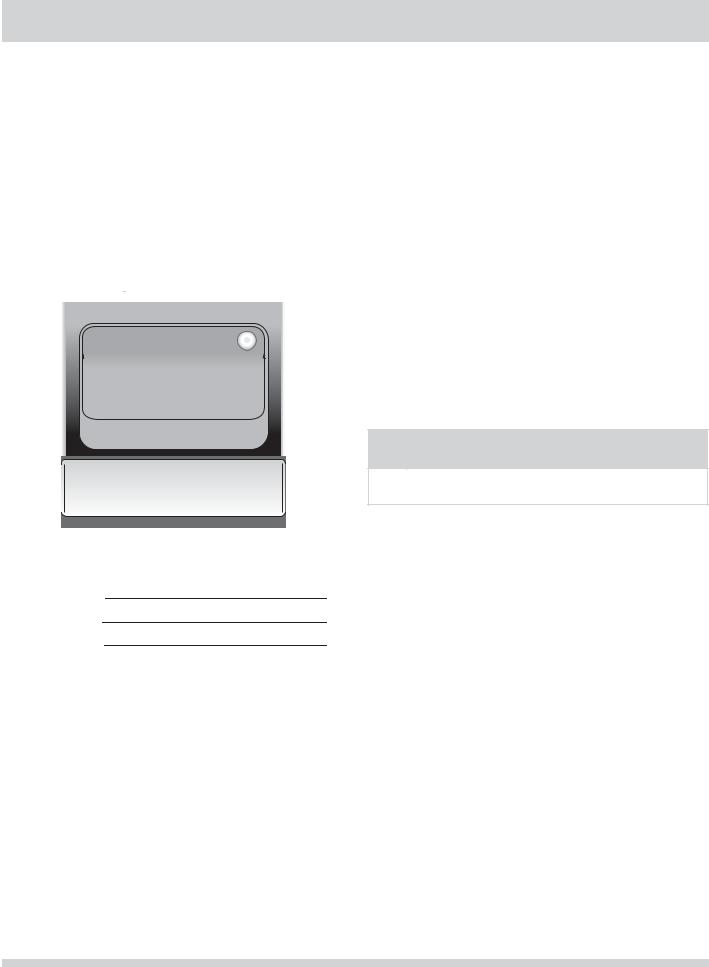
WELCOME & CONGRATULATIONS
Product Registration
Register Your Product
The PRODUCT
REGISTRATION CARD 
 should be filled in completely,
should be filled in completely, 
 signed and returned to
signed and returned to 



 Electrolux Home Products.
Electrolux Home Products. 






Serial Plate Location
Please record your model and serial numbers below for future reference.
Model Number:
Serial Number:
Purchase Date:
Congratulations on your purchase of a new appliance! At
Electrolux Home Products, we are very proud of our product and are completely committed to providing you with the best service possible. Your satisfaction is our number one priority.
We know you’ll enjoy your new appliance and Thank You for choosing our product. We hope you consider us for future purchases.
PLEASE CAREFULLY READ AND SAVE THESE INSTRUCTIONS
This Use & Care Manual contains general operating instructions for your appliance and feature information for several models. Your product may not have
all the described features. The graphics shown are representative. The graphics on your appliance may not look exactly like those shown. These instructions are not meant to cover every possible condition and situation that may occur. Common sense and caution must be practiced when installing, operating and maintaining any appliance.
NOTE
Please attach sales receipt here for future reference.
©2012 Electrolux Canada Corp. All rights reserved
Printed in Canada
2
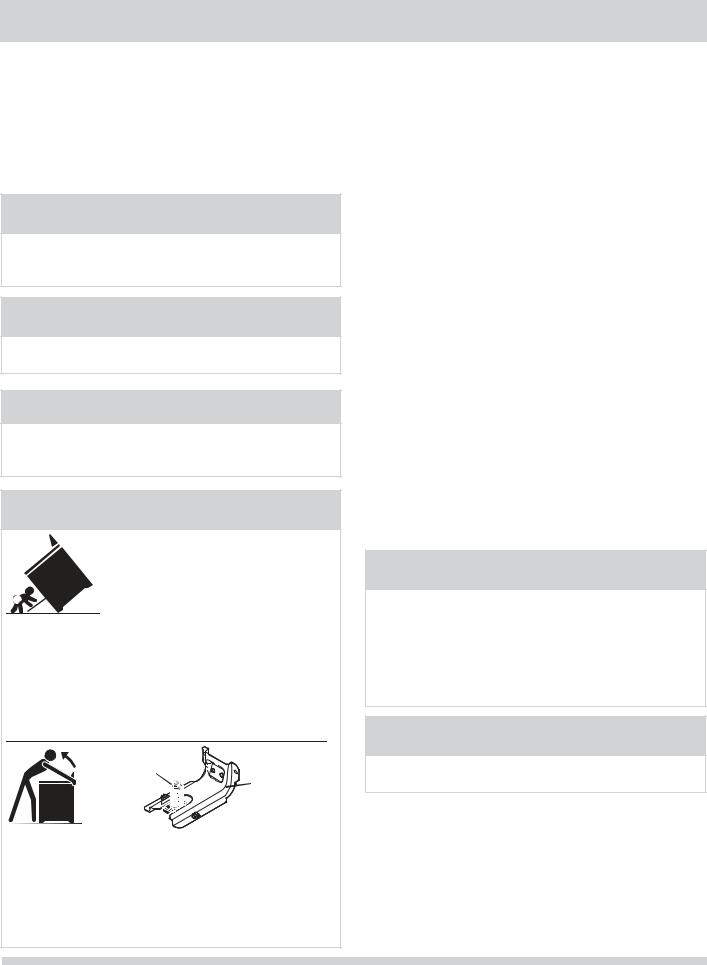
IMPORTANT SAFETY INSTRUCTIONS
Read all instructions before using this appliance. Save these instructions for future reference.
DEFINITIONS
 This is the safety alert symbol. It is used to alert you to potential personal injury hazards. Obey all safety
This is the safety alert symbol. It is used to alert you to potential personal injury hazards. Obey all safety
messages that follow this symbol to avoid possible injury or death.

 WARNING
WARNING
This symbol will help alert you to situations that may cause serious bodily harm, death or property damage.

 CAUTION
CAUTION
This symbol will help alert you to situations that may cause bodily injury or property damage.

 IMPORTANT
IMPORTANT
IMPORTANT indicates installation, operation or maintenance information which is important but not hazard-related.

 WARNING
WARNING
Tip Over Hazard
• A child or adult can tip the range and be killed.
• Verify the anti-tip device has been installed to floor or wall.
•Ensure the anti-tip device is re-engaged to floor or wall when the range is moved.
•Do not operate the range without the anti-tip device in place and engaged.
•Failure to follow these instructions can result in death or serious burns to children and adults.
Range |
|
Leveling |
Anti-Tip |
Leg |
|
|
Bracket |
To check if the anti-tip bracket is installed properly, use both arms and grasp the rear edge of range back. Carefully attempt to tilt range forward. When properly installed, the range should not tilt forward.
Refer to the anti-tip bracket installation instructions supplied with your range for proper installation.
•Remove all tape and packaging wrap before using the appliance. Destroy the carton and plastic bags after unpacking the appliance. Never allow children to play with packaging material. Do not remove the wiring label and other literature attached to the appliance. Do not remove model/serial number plate.
•Proper Installation. Be sure your appliance is properly installed and grounded by a qualified technician in accordance in the United States with the National Electrical Code ANSI/NFPA No. 70-latest edition, and local code requirements, and in Canada with CSA C22.1 PART 1-latest edition and local code requirements. Install only per installation instructions provided in the literature package for this range.
Ask your dealer to recommend a qualified technician and an authorized repair service. Know how to disconnect the electrical power to the appliance at the circuit breaker or fuse box in case of an emergency.
•User Servicing. Do not repair or replace any part of the appliance unless specifically recommended in the manuals. All other servicing should be done only by a qualified technician to reduce the risk of personal injury and damage to the appliance.
•Never modify or alter the construction of an appliance by removing leveling legs, panels, wire covers, anti-tip brackets/screws, or any other part of the product.

 WARNING
WARNING
Stepping, leaning, sitting or pulling down on the door or the drawer of this appliance can result in serious injuries and also cause damage to the appliance. Do not allow children to climb or play around the appliance. The weight of a child on an open door may cause the appliance to tip, resulting in serious burns or other injury. An open drawer when hot may cause burns.

 WARNING
WARNING
Do not use the oven or warm & serve drawer (if equipped) for storage.
• Storage in or on Appliance. Flammable materials should not be stored in an oven, near surface burners or in the warm & serve drawer (if equipped). This includes paper, plastic and cloth items, such as cookbooks, plastic ware and towels, as well as flammable liquids. Do not store explosives, such as aerosol cans, on or near the appliance. Flammable materials may explode and result in fire or property
damage.
3

IMPORTANT SAFETY INSTRUCTIONS

 CAUTION
CAUTION
Do not store items of interest to children in the cabinets above the appliance. Children climbing on the cooktop to reach items could be seriously injured.
•Do not leave children alone. Children should not be left alone or unattended in the area where an appliance is in use. They should never be allowed to sit or stand on any part of the appliance.
•DO NOT TOUCH SURFACE UNITS, AREAS NEAR THESE UNITS, OVEN HEATING ELEMENTS OR INTERIOR SURFACES OF THE OVEN. Both surface units and oven heating elements may be hot even though they are dark in color. Areas near surface units may become hot enough to cause burns. During and after use, do not touch, or let clothing or other flammable materials touch these areas until they have had sufficient time to cool. Among these areas are the cooktop, surfaces facing the cooktop, the oven vent openings and surfaces near these openings, oven door and window.
•Wear Proper Apparel. Loose-fitting or hanging garments should never be worn while using the appliance. Do not let clothing or other flammable materials contact hot surfaces.

 WARNING
WARNING
NEVER use your appliance as a space heater to heat or warm the room.
•Do Not Use Water or Flour on Grease Fires. Smother the fire with a pan lid, or use baking soda, a dry chemical or foam-type extinguisher.
•When heating fat or grease, watch it closely. Fat or grease may catch fire if allowed to become too hot.
•Use Only Dry Pot holders. Moist or damp pot holders on hot surfaces may result in burns from steam. Do not let the pot holders touch hot surface units. Do not use a towel or other bulky cloth instead of a pot holder.
•Do Not Heat Unopened Food Containers. Buildup of pressure may cause the container to burst and result in injury.
•Remove the oven door from any unused appliance if it is to be stored or discarded.

 IMPORTANT
IMPORTANT
Do not attempt to operate the appliance during a power failure. If the power fails, always turn off the unit. If the unit is not turned off and the power resumes, the appliance will not operate and an error message will be displayed. Once the power resumes, reset the clock and the oven function.

 CAUTION
CAUTION
Electronic controllers can be damaged by cold temperatures. When you use your appliance for the first time, or if it has not been used for a long period of time, make sure that it has been exposed to a temperature above 0°C/32°F for at least 3 hours before connecting it to the power supply.
IMPORTANT INSTRUCTIONS FOR USING YOUR COOKTOP
•Know which knob controls each surface heating unit. Place pan of food on the element before turning it on, and turn the element off before removing the pan.
•Use Proper Pan Size—This appliance is equipped with one or more surface burners of different sizes. Select utensils having flat bottoms large enough to cover the surface unit. The use of undersized utensils will expose a portion of surface heating unit to direct contact and may result in ignition of clothing. Proper relationship of utensil to the surface will also improve efficiency.
•Utensil Handles Should Be Turned Inward and Should Not Extend Over Adjacent Surface Units—To reduce the risk of burns, ignition of
flammable materials, and spillage due to unintentional contact with the utensil. The handle of the utensil should be positioned so that it is turned inward, and does not extend over adjacent surface unit.
•Never Leave Surface Units Unattended—Boilovers cause smoking and greasy spillovers that may ignite, or a pan that has boiled dry may melt.
•Protective Liners—Do not use aluminum foil to line oven bottom or any other part of the appliance. Only use aluminum as recommended for baking if used as a cover placed on the food. Any other used of protective liners or aluminum foil may result in a risk of electric shock or fire or a short circuit.
•Glazed Cooking Utensils—Only certain types of glass, glass/ceramic, ceramic, earthenware, or other glazed utensils are suitable for cooktop service without breaking due to the sudden change in temperature. Check the manufacturer’s recommendations for cooktop use.
4

IMPORTANT SAFETY INSTRUCTIONS
•Do Not Use Decorative Surface Burner Covers.
If an element is accidentally turned on, the decorative cover will become hot and possibly melt. Burns will occur if the hot covers are touched. Damage may also be done to the cooktop.
FOR COOKTOPS WITH COIL ELEMENTS ONLY
•Do Not Immerse or Soak Removable Surface Heating Elements. Surface heating elements should never be immerse in water. Heating elements clean themselves during normal operation.
•Make Sure Drip Pans or Drip Bowls Are in Place. Absence of these pans or bowls during cooking may subject wiring or components underneath to damage.
FOR GLASS COOKTOP ONLY
•Do Not Clean or Operate a Broken Cooktop— If cooktop should break, cleaning solutions and spillovers may penetrate the broken cooktop and create a
risk of electric shock. Contact a qualified technician immediately.
•Clean Cooktop Glass with Caution— If a wet sponge or cloth is used to wipe spills on a hot cooking area, be careful to avoid a steam burn. Some cleaners can produce harmful fumes if applied to a hot surface.
•Avoid Scratching the Cooktop Glass with Sharp Objects.
IMPORTANT SAFETY INSTRUCTIONS FOR USING YOUR OVEN
•Use Care When Opening Oven Door—Stand to the side of the appliance when opening the door/drawer of a hot appliance. Let hot air or steam escape before you remove or replace food in the oven/drawer.
•Keep Oven Vent Ducts Unobstructed. The oven is vented at the front above the oven door. Touching the surfaces in this area when the oven is operating may cause severe burns. Also, do not place plastic or heatsensitive items on or near the oven vent. These items could melt or ignite.

 WARNING
WARNING
NEVER cover any slots, holes or passages in the oven bottom or cover an entire rack with materials such as aluminum foil. Doing so blocks air flow through the oven and may cause carbon monoxide poisoning. Aluminum foil linings may trap heat, causing a fire hazard.
•Placement of Oven Racks. Always place oven racks in desired location while appliance is cool. Remove all utensils from the rack before removing rack. If rack must be moved while oven is hot, use extreme caution.
Use pot holders and grasp the rack with both hands to reposition. Do not let pot holders contact the hot oven element or interior of the oven.
•Do not use a broiler pan without its insert. Broiler pan and grid allow dripping fat to drain and be kept away from the high heat of the broiler.
•Do not cover the broiler grid or oven bottom with aluminum foil. Exposed fat and grease could ignite.
•Do not touch a hot oven light bulb with a damp cloth. Doing so could cause the bulb to break. Disconnect the appliance or shut off the power to the appliance before removing and replacing the bulb.
IMPORTANT SAFETY INSTRUCTIONS FOR CLEANING YOUR OVEN
•Clean the appliance regularly to keep all parts free of grease that could catch fire. Exhaust fan ventilation hoods and grease filters should be kept clean. Do not allow grease to accumulate. Greasy deposits in the fan could catch fire. Refer to the hood manufacturer’s instructions for cleaning.
•Cleaners/Aerosols—Always follow the manufacturer’s recommended directions for use. Be aware that excess residue from cleaners and aerosols may ignite causing damage and/or injury.
FOR SELF-CLEANING OVEN
•Clean in the self-cleaning cycle only the parts of the appliance listed in this Owner’s Guide. Before using the self-cleaning cycle of the appliance, remove all utensils stored in the appliance.
•Do not clean the oven door gasket. The door gasket is essential for a good seal. Care should be taken not to rub, damage or move the gasket.
•Do not use oven cleaners. No oven cleaner or oven liner protective coating of any kind should be used in or around any part of the appliance.
•Remove oven racks. Oven racks color will change if left in the oven during a self-cleaning cycle.

 CAUTION
CAUTION
The health of some birds is extremely sensitive to the fumes given off during the self-clean cycle of any wall oven. Move birds to another well ventilated room.

 IMPORTANT SAFETY NOTICE
IMPORTANT SAFETY NOTICE
The California Safe Drinking Water and Toxic Enforcement Act requires the Governor of California to publish a list of substances known to the state to
cause cancer, birth defects or other reproductive harm, and requires businesses to warn customers of potential
exposure to such substances.
5
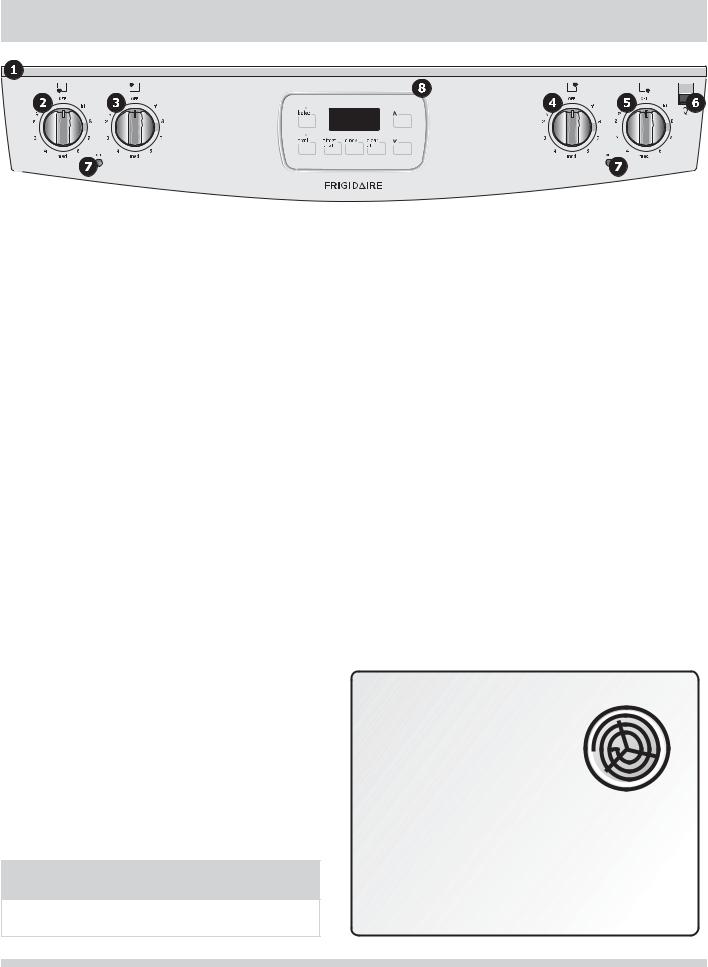
FEATURES AT A GLANCE - MODEL A
Your built-in range Features:
1. Control Panel.
2.Left front element control.
3. Left rear element control.
4. Right rear element control.
5.Right front element control.
6. Oven light switch.
7. Element on indicator lights.
8. Electronic oven control with kitchen timer.
9.Automatic oven door light switch.
10.Broil element.
11. Manual clean oven interior.
12. Oven interior light with removable cover.
13. Adjustable interior oven rack(s).
14. Large 1-piece oven door handle.
15.Oven door with window.
16.Storage drawer with integrated handle
(available with some models only).
17.8” Coil element.
18.6” Coil element.
19.6” Coil element.
20.8” Coil element.
NOTE
The features shown for your appliance may vary according to model type & color.
6
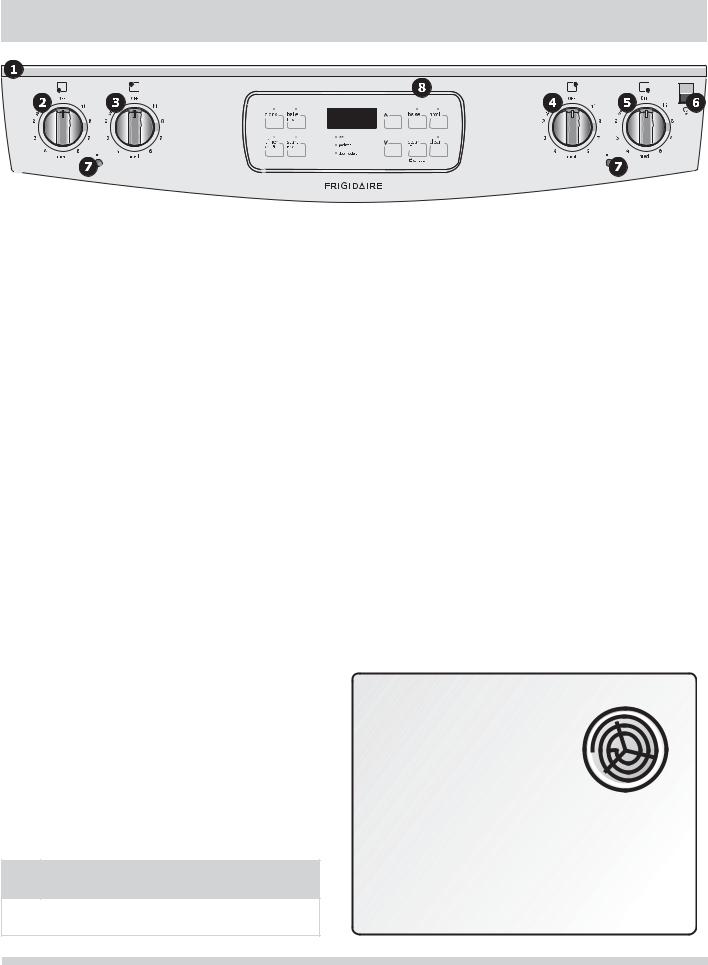
FEATURES AT A GLANCE - MODEL B
Your built-in range Features:
1. Control Panel.
2.Left front element control.
3. Left rear element control.
4. Right rear element control.
5. Right front element control.
6. Oven light switch.
7. Element on indicator lights.
8. Electronic oven control with kitchen timer.
9.Automatic oven door light switch.
10.Self-clean door latch.
11. Broil element.
12. Self-cleaning oven interior.
13. Oven interior light with removable cover.
14. Adjustable interior oven rack(s).
15.Large 1-piece oven door handle.
16.Full width oven door with window.
17. Large 1-piece drawer handle
(Stainless steel models with drawer only).
18.Storage drawer with integrated handle (Available with some models only).
19.8” Coil element.
20. 6” Coil element.
21.6” Coil element.
22.8” Coil element.
NOTE
The features shown for your appliance may vary according to model type & color.
7
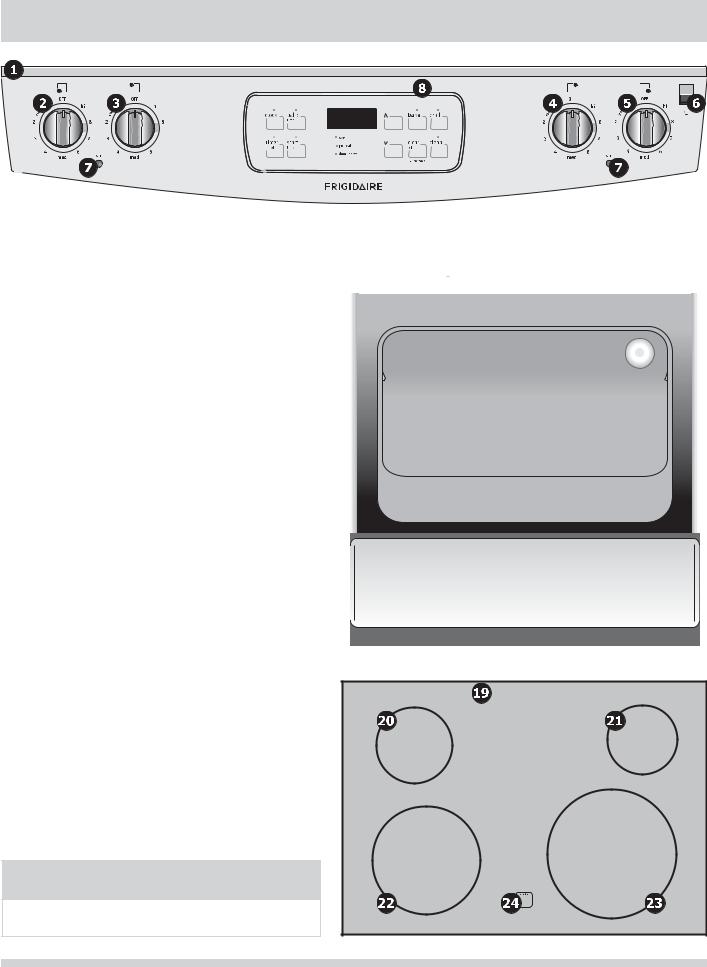
FEATURES AT A GLANCE - MODEL C
Your built-in range Features:
1. Control Panel.
2.Left front element control.
3. Left rear element control.
4.Right rear element control.
5. Right front element control.
6. Oven light switch.
7. Element on indicator lights.
8. Electronic oven control with kitchen timer.
9.Automatic oven door light switch.
10.Self-clean door latch.
11. Broil element.
12. Self-cleaning oven interior.
13. Oven interior light with removable cover.
14. Adjustable interior oven rack(s).
15.Large 1-piece oven door handle.
16.Full width oven door with window.
17.Large 1-piece drawer handle
(Stainless steel models with drawer only). 18. Storage drawer with integrated handle
(Available with some models only).
19. Ceramic glass cooktop.
20. 7” single radiant element
21.6” single radiant element.
22.9” single radiant element.
23.12” single radiant element.
24.Hot surface indicator light
NOTE
The features shown for your appliance may vary according to model type & color.
8
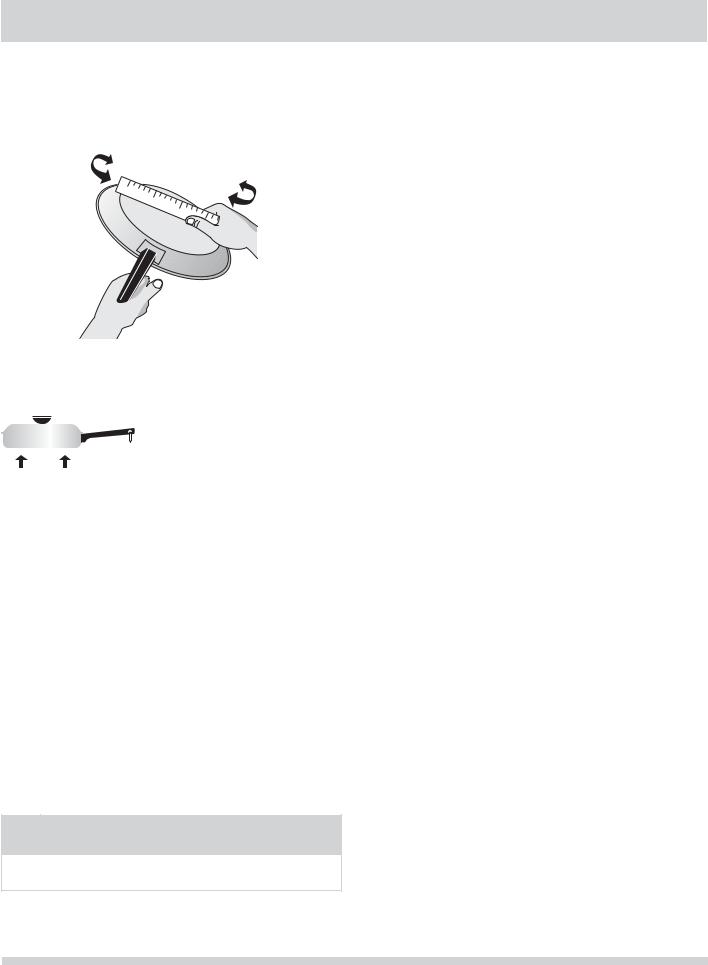
Selecting Surface Cooking Cookware
Cookware should have flat bottoms that make good contact with the entire surface heating element. Check for flatness by rotating a ruler across the bottom of the cookware (See Figure 1).
Figure 1
Be sure to follow the recommendations for using cookware as shown in Figure 2.
CORRECT |
|
INCORRECT |
|||||||||||||||||||||||
|
|
|
|
|
|
|
|
|
|
|
|
|
|
|
|
|
|
|
|
|
|
|
|
|
|
|
|
|
|
|
|
|
|
|
|
|
|
|
|
|
|
|
|
|
|
|
|
|
|
|
|
|
|
|
|
|
|
|
|
|
|
|
|
|
|
|
|
|
|
|
|
|
|
|
|
|
|
|
|
|
|
|
|
|
|
|
|
|
|
|
|
|
|
|
|
|
|
|
|
|
|
|
|
|
|
|
|
|
|
|
|
|
|
|
|
|
|
|
|
|
|
|
|
|
|
|
|
|
|
|
|
|
|
|
|
• Curved and warped pan |
|||||||||||||||||||
• Flat bottom and straight |
|||||||||||||||||||||||||
|
|
|
|
|
bottoms. |
||||||||||||||||||||
|
|
sides. |
|
|
|
|
|
|
|
|
|
|
|
|
|
|
|
|
|
|
|
|
|||
• Tight fitting lids. |
|
|
|
|
|
|
|
|
|
|
|
|
|
|
|
|
|
|
|
|
|||||
|
|
|
|
|
|
|
|
|
|
|
|
|
|
|
|
|
|
|
|
||||||
|
|
|
|
|
|
|
|
|
|
|
|
|
|
|
|
|
|
|
|
||||||
• Weight of handle does |
|
|
|
|
|
|
|
|
|
|
|
|
|
|
|
|
|
|
|
|
|||||
|
• Pan overhangs unit by |
||||||||||||||||||||||||
|
|
not tilt pan. Pan is well |
|
||||||||||||||||||||||
|
|
|
|
|
|
|
|
more than one-half inch. |
|||||||||||||||||
|
|
balanced. |
|
|
|
|
|
|
|||||||||||||||||
|
|
|
|
|
|
|
|
|
|
|
|
|
|
|
|
|
|
|
|
|
|
||||
• Pan sizes match the |
|
|
|
|
|
|
|
|
|
|
|
|
|
|
|
|
|
|
|
|
|||||
|
|
|
|
|
|
|
|
|
|
|
|
|
|
|
|
|
|
|
|
||||||
|
|
|
|
|
|
|
|
|
|
|
|
|
|
|
|
|
|
|
|
||||||
|
|
amount of food to be |
|
|
|
|
|
|
|
|
|
|
|
|
|
|
|
|
|
|
|
|
|||
|
|
|
|
|
|
|
|
|
|
|
|
|
|
|
|
|
|
|
|
|
|
||||
|
|
prepared and the size |
|
• Pan is smaller than the |
|||||||||||||||||||||
|
|
of the surface element. |
|
||||||||||||||||||||||
|
|
|
|
|
|
|
|
element. |
|||||||||||||||||
• Made of material that |
|
|
|
|
|
|
|
|
|
|
|
|
|
|
|
|
|
|
|
|
|||||
|
|
conducts heat well. |
|
|
|
|
|
|
|
|
|
|
|
|
|
|
|
|
|
|
|
|
|||
|
|
|
• Heavy handle tilts the |
||||||||||||||||||||||
• Easy to clean. |
|
||||||||||||||||||||||||
|
|
|
|
|
|
pan. |
|||||||||||||||||||
• Always match pot |
|
|
|
|
|
|
|||||||||||||||||||
|
|
|
|
|
|
|
|
|
|
|
|
|
|
|
|
|
|
|
|
||||||
|
|
diameter to element |
|
|
|
|
|
|
|
|
|
|
|
|
|
|
|
|
|
|
|
|
|||
|
|
surface diameter. |
Figure 2 |
||||||||||||||||||||||
|
|
|
|
|
|||||||||||||||||||||
NOTE
The size and type of cookware used will influence the setting needed for best cooking results.
SURFACE COOKING
Cookware Material types
The cookware material determines how evenly and quickly heat is transferred from the surface element to the pan bottom. The most popular materials available are:
ALUMINUM- Excellent heat conductor. Some types of food will cause it to darken (Anodized aluminum cookware resists staining & pitting). If aluminum pans slide across the ceramic glass cooktop, they may leave metal marks which will resemble scratches. Remove these marks immediately.
COPPER- Excellent heat conductor but discolors easily. May leave metal marks on ceramic glass (see Aluminum above).
STAINLESS STEEL- Slow heat conductor with uneven cooking results. Is durable, easy to clean and resists staining.
CAST IRON- A poor heat conductor however will retain heat very well. Cooks evenly once cooking temperature is reached. Not recommended for use on ceramic cooktops.
PORCELAIN-ENAMEL on METAL- Heating characteristics will vary depending on base material. Porcelain-enamel coating must be smooth to avoid scratching ceramic cooktops.
GLASS- Slow heat conductor. Not recommended for ceramic cooktop surfaces because it may scratch the glass.
9
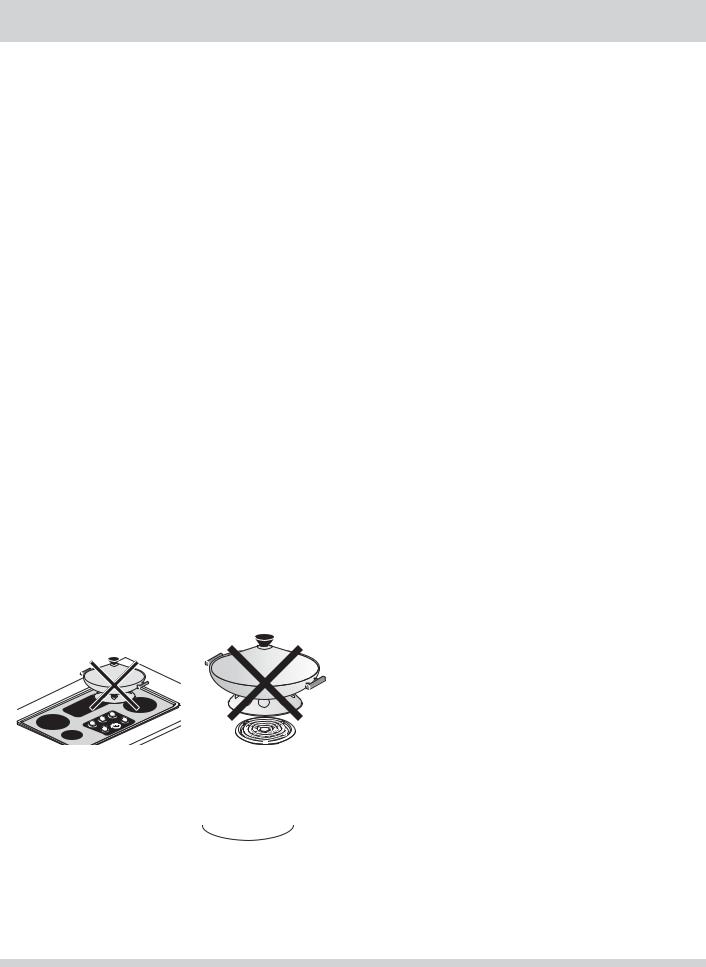
SURFACE COOKING
Specialty Pans & Trivets
Woks with flat bottoms suitable for use on your cooktop are available in most cookshop or hardware stores. Round-bottomed woks (with a support ring that does not extend beyond the heating element) may also be used. The metal ring was designed to support the wok safely when it is filled with large amounts of liquids (soup making) or fat (frying).

 CAUTION
CAUTION
DO NOT use two elements (if the cooktop is not equipped with bridge element) to heat one large pan such as a roaster or griddle, or allow cooking utensils to boil dry. The bottom surface of the pan in either of these situations could cause discoloring or crazing of the porcelain enamel range surface, and damage to the surface elements and/ or damage to the drip pans (if equipped).
Wire trivets: Do not use wire trivets. Cookware bottoms must be in direct contact with the surface elements.
DO NOT use a wok if it is equipped with a metal ring that extends beyond the surface element. Because this ring traps heat, the surface element and cooktop surface could be damaged.
For glass smoothtop models, only flat bottomed woks (without support rings) may be used.
Canning Tips & Information
1.Use tested recipes and follow instructions carefully. Check with your local Cooperative Agricultural Extension Service or a manufacturer of glass jars for the latest canning information.
2.Use flat-bottomed canners only. Heat is spread more evenly when the bottom surface is flat.
3.Center canner on the burner grate.
4.Start with hot water and a high heat setting to reduce the time it takes to bring the water to a boil; then reduce the heat setting as low as possible to maintain a constant boil.
5.It is best to can small amounts and light loads.

 CAUTION
CAUTION
Canning can generate large amounts of steam. Use extreme caution to prevent burns. Always raise the lid to vent steam away from you.
Prevent damage to cooktop and burner grates:
1.Do not use water bath or pressure canners that extend more than one inch beyond the edge of the burner grate.
2.Do not leave water bath or pressure canners on high heat for an extended amount of time.
3.Alternate surface units between each batch to allow the units and surrounding surfaces to cool down. Try to avoid canning on the same burner unit all day.
Safe canning requires that harmful micro-organisms are destroyed and the jars are sealed completely. When canning in a water bath canner, a gentle but steady boil must be maintained continuously for the required time.
10
